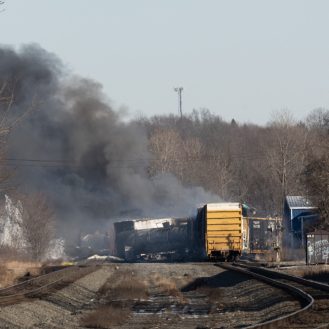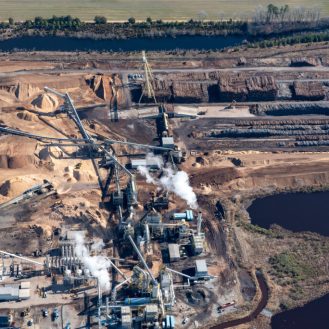For years, opponents of wind energy development have argued that the projects lead to a decrease in property values, despite the companies proposing the projects saying there was almost no evidence to support such claims.
A new paper published in the journal Energy Policy is likely to shake up this debate with its finding that properties within a mile of a proposed wind farm experience an average decrease in value of 11 percent following the announcement of the project, compared to properties located three to five miles away.
The decrease in property value begins after the wind farm is announced and continues during construction. But the difference fades away a few years after the project is operational to the point that properties within a mile of a project have values that are indistinguishable from those three to five miles from a project.
“The potential for a wind project is something that people are reacting to,” said Ben Hoen, a co-author of the paper and a research scientist at the Lawrence Berkeley National Laboratory.
It’s not much of a stretch to foresee opponents of wind farms highlighting the 11 percent decrease in property values from the paper without mentioning that this difference fades to zero over time.

I asked Hoen what he thinks of the possibility that aspects of this research could be cherry-picked to argue against development.
“I can’t speak for people that are using it incorrectly,” he said.
The main caveat, he said, is that the paper doesn’t take into account any of the financial benefits of wind farms, which might affect all homes in the area and could include an infusion of new revenue for local governments and schools. For some, or even many, of the people living within a mile of a wind farm, the benefits may outweigh the temporary loss in property value.
The paper also finds that the negative effects on property values were apparent for wind farms near metro areas, while the effects were not apparent outside of metro areas.
Why the discrepancy? I asked Hoen.
“We can only hypothesize,” he said. “But one of the theories out there that’s been supported by other research is that individuals that are in those urban fringe areas value the landscape differently than people in more rural areas. They might value all the open space because there isn’t as much of it. They might place more value on the views from their homes than individuals that are in a working rural environment.”
Hoen is a leading researcher on the effects of renewable energy development on other variables, such as property values. I wrote in March about a paper he co-authored about solar projects and property values, showing a small negative effect for homes located near projects in some states, and no effect in other states.
I reached out to Sarah Mills of the University of Michigan, who has written about community attitudes on renewable energy development, to get her reaction. She has collaborated with Hoen in the past but was not involved in this paper.
“As we deploy things, more becomes known once the impacts have time to play out in communities,” she said. “So I think that this paper is certainly something that is going to factor into community conversations.”
She noted that some of the most widely cited studies of wind energy and U.S. property values showed little or no measurable negative effect, so these results differ from previous information.
Hoen co-authored some of those earlier studies and, as he continues to work on the subject, he is able to draw on larger sets of data to measure property values as more projects get built and more time passes. The new paper is based on an analysis of a sample of 428 wind farms in the United States and about 500,000 sales of properties located within five miles of one of the wind farms.
Hoen said his goal with this work is to provide information that can help communities to make sense of complex questions about wind farm development.
“It’s extremely important for them to have good information on which to make those decisions,” he said.
Other stories about the energy transition to take note of this week:
Tesla Blamed Drivers for Failures of Parts It Knew Were Defective: Tesla documents show that the company was aware of chronic flaws and failures in its car parts for years, but still blamed customers for the problems, as Hyunjoo Jin, Kevin Krolicki, Marie Mannes and Steve Stecklow report for Reuters. The automaker would refuse to pay for repairs of some parts, even in cases where it knew the problem was likely due to defects that were not the customers’ fault. This story includes some impressive reporting of troubling conduct by Tesla. As we’ve come to expect, neither Tesla CEO Elon Musk nor any of his companies responded to requests for comment.
Anonymously Funded Group Stokes Opposition to Ohio Solar Project: A group called Knox Smart Development is trying to organize people in Knox County, Ohio, to oppose a proposed 120-megawatt solar farm. The group doesn’t list its donors, but Kathiann Kowalski reports for Energy News Network that there are some clear connections with the Empowerment Alliance, which has links to the natural gas industry. The Knox County group held an event on Nov. 30 at a local theater in which speakers encouraged opposition to the project, while a representative of the solar farm’s developer, Open Road Renewables, was denied entry.
This story is funded by readers like you.
Our nonprofit newsroom provides award-winning climate coverage free of charge and advertising. We rely on donations from readers like you to keep going. Please donate now to support our work.
Here’s How Experts Graded U.S. Climate and Clean Energy Progress in 2023: From a strong A- to an F, Grist asked experts to grade how effectively the United States made progress on climate and clean energy. Ari Matusiak, CEO of the nonprofit Rewiring America, gave the highest grade, an A-, which he attributed to the investments made possible by the Inflation Reduction Act, and various indicators of clean energy progress. Anna Liljedahl, an associate scientist at Woodwell Climate Research Center, issued an F, which she said was due to a patent system that limits the ability to use some of the technologies that already exist.
A Scaled-Back Lease Proposal For Atlantic Offshore Wind Projects Prompts Questions and Criticism: Clean energy industry groups and environmental advocates say that the Biden administration’s latest lease offering for offshore wind projects doesn’t have enough acreage for Maryland and other mid-Atlantic states to achieve their legally binding emissions reduction targets. The proposed leases include an area off of Delaware and Maryland and another off of Virginia, which can support 4 to 8 gigawatts of electricity generating capacity, as Aman Azhar reports for ICN. But the administration didn’t include an area off of Ocean City, Maryland, apparently because of concerns expressed by the Coast Guard and the Department of Defense, among others.
Can the Grid Keep Up with Spiking Electricity Demand?: The consulting firm Grid Strategies has issued a report, The Era of Flat Power Demand Is Over, that looks at a shift taking place from an era in which there was little growth in electricity demand to one in which the authors expect substantial growth. Jeff St. John writes for Canary Media about the report and its implications for the transition to clean energy. One of the big concerns is that the grid isn’t growing fast enough to cover the anticipated growth in demand, which touches on a point that Grid Strategies has been highlighting for a while about the need for a building boom in interstate power lines.
Treasury Department Unveils Rules for Clean Energy Manufacturing Subsidy: The U.S. Treasury Department has published proposed guidelines for manufacturers that want to claim a tax credit for making clean energy components such as solar panels and batteries, as Timothy Gardner and Nichola Groom report for Reuters. Reaction from industries was mixed, with the Solar Energy Industries Association praising the agency for provisions that allow companies with contracted manufacturers to qualify for the credit, and the National Mining Association criticizing the agency for excluding raw materials from one part of the credit. The 25-page proposed rule lays out how manufacturers can qualify for tax credits on a percentage of their production costs; the percentage varies depending on what is being produced, with batteries, for example, receiving a credit of 10 percent.
Inside Clean Energy is ICN’s weekly bulletin of news and analysis about the energy transition. Send news tips and questions to [email protected].









